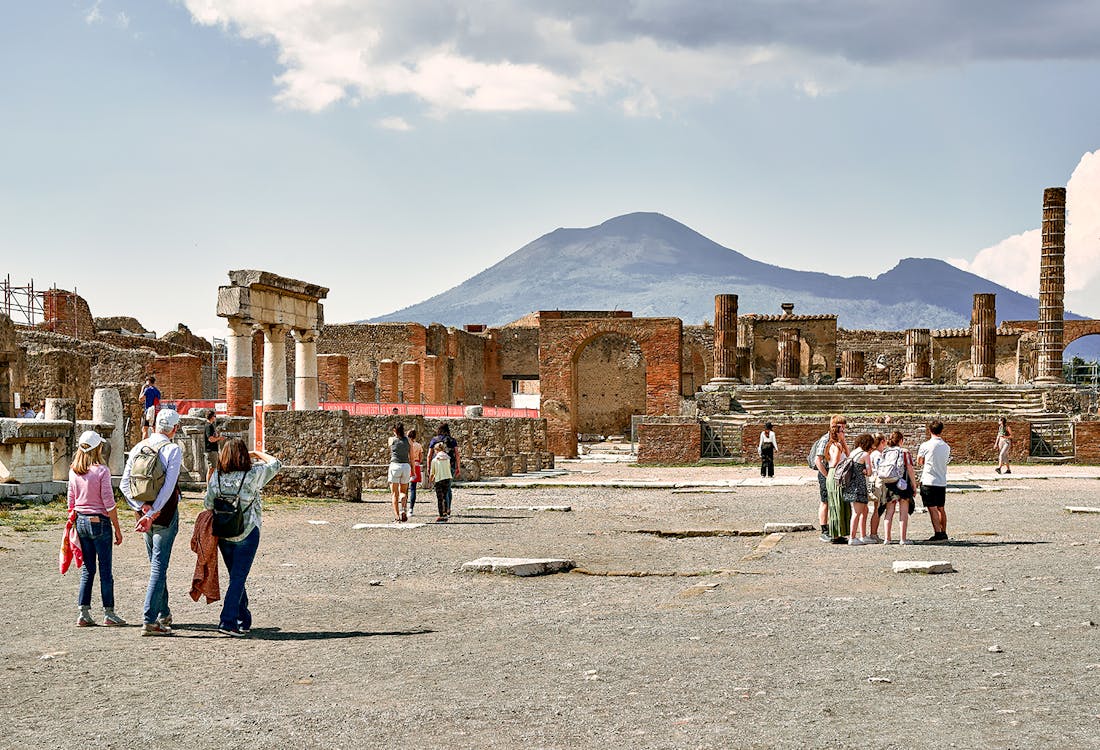Frozen in time beneath the ash of Mount Vesuvius, Pompeii stands as one of the world’s most haunting archaeological wonders. Ancient streets, vibrant frescoes, and remnants of daily life tell the story of a thriving Roman city abruptly halted in AD 79. When you visit Pompeii, you’ll be wandering past temples, bathhouses, and villas that still echo with the spirit of a civilization both sophisticated and fragile. And with an archaeologist by your side, it's even more easier to understand how Pompeii was discovered, excavated, and what its preserved streets and artifacts reveal about our shared human history.
How was Pompeii discovered?
The story of Pompeii’s rediscovery begins in the late 16th century, when Renaissance architect Domenico Fontana stumbled upon ancient walls decorated with frescoes and inscriptions while digging an underground aqueduct in 1592. He realized he had uncovered a lost city, but the discovery was more of a curiosity than a project. The details were scarce, and no serious exploration happened for the next 150 years. Locals called the area “La Cività”, or “The City,” and though artifacts occasionally surfaced, the ruins remained mostly forgotten, shrouded in legend.
In the mid-18th century, under Charles III of Bourbon, King of Naples, proper excavations began led by the Spanish engineer Roque Joaquín de Alcubierre. At first, the digs were focused more on uncovering treasures for the royal collection than on studying the city itself. Then, in 1763, a remarkable discovery changed everything. They found an inscription naming the city “Pompeii” thereby confirming that the long-lost city had finally been found.
Over a century later, Giuseppe Fiorelli, appointed director in 1860, revolutionized the way Pompeii was explored. He divided the city into regions and blocks, meticulously documenting each find. Most famously, he developed the technique of making plaster casts of victims of the eruption, filling the cavities left by decomposed bodies in the ash. Subsequently, many excavations took place that restored the city of Pompeii to what you see today.
Why take a Pompeii tour with an archaeologist?

1. Learn about excavation techniques and recent discoveries
Discover how archaeologists carefully unearth Pompeii’s hidden treasures, from fragile frescoes to perfectly preserved mosaics. Learn about plaster cast techniques that reveal the final moments of Pompeii’s residents and hear about recent finds that continue to reshape our understanding of the city.
2. Understand daily Roman life through expert storytelling
Buried under volcanic ash for more than a millennium, Pompeii tours offer a rare glimpse into how ancient Romans truly lived. Its streets, homes, and marketplaces have been carefully restored, preserving an entire city exactly as it was at the moment time stood still. Hear how families dined, merchants sold their goods, and children played in courtyards; all through fascinating stories and observations only an archaeologist can share. There’s much more to uncover on the tour.
3. Ask questions directly to a field specialist
Engage with an archaeologist who has spent years studying Pompeii up close. Ask about mysterious inscriptions, architectural choices, or even the volcanic eruption itself, and gain insights you won’t find in guidebooks. Every answer opens the door to discoveries you’ll experience firsthand on the tour.
Interesting archaeological facts about Pompeii
- The ancient fast-food counters called thermopolia were uncovered. They even found remnants of meals including duck, goat, pig, fish, and snails, along with brightly colored frescoes depicting the food on offer, showing daily eating habits of Romans.
- A lavish private bathhouse, possibly the largest ever found, features hot, warm, and cold rooms along with stunning artwork and a massive plunge pool. The bathhouse plumbing system was so advanced that valves regulating water flow appear strikingly modern.
- Recent discoveries include life-sized statues of a man and woman, finely detailed in clothing and accessories. One statue depicts a woman wearing a ceremonial veil and a crescent moon-shaped pendant, suggesting she was a priestess of Ceres.
- Excavations uncovered the remains of horses in a prestigious suburban villa stable, with military harnesses and bronze fittings, indicating the presence of wealthy and possibly military residents with horses prepared for riding or combat.
- The plaster cast technique developed by Giuseppe Fiorelli in the 19th century revolutionized archaeology at Pompeii by filling voids left by decomposed bodies in ash with plaster to capture the exact forms and expressions of eruption victims. You can see a hauntingly detailed cast of a man frozen in the final moments of escape.
- A monumental tomb of Marcus Venerius Secundio was found, containing one of the best-preserved skeletons with soft tissue still visible. The tomb had inscriptions revealing performances in Greek at Pompeii’s theaters, providing evidence of the cultural diversity of the city.
- Archaeologists recently discovered evidence that survivors returned to Pompeii after the eruption, resettling and repurposing buildings. Finds include bread ovens and Christian symbols, indicating a post-eruption partial revival, which many visitors typically overlook amidst the ruins.
Pompeii tour with archaeologist

